Introduction to Badshahi Mosque:-
The Badshahi Mosque, known as Badshahi Masjid (بادشاہی مسجد) in Urdu, is a magnificent Mughal-era mosque located in Lahore, Punjab, Pakistan. It stands opposite the Lahore Fort and is considered one of Lahore’s most iconic landmarks. The mosque was commissioned by the sixth Mughal Emperor, Aurangzeb, and constructed between 1671 and 1673. The Badshahi Masjid Lahore was the largest mosque in the world for over 300 years.
It is an exemplary piece of Mughal architecture, adorned with carved red sandstone and marble inlay. Notably, it remains the largest Mughal mosque and is the third-largest mosque in Pakistan. The Badshahi Mosque is constructed over 276,000 square feet. The mosque can accommodate 100,000 worshippers. There are 8 minarets, with 4 major ones at the corners of the mosque and 4 minor ones. The major minarets are 226 feet 4.5 inches (68.999 meters) tall, and the four octagonal three-story minarets are 196 feet high. The mosque features three domes, with the central one slightly larger than the others. These domes are made of white marble and are a prominent feature of the mosque’s silhouette.
Throughout its history, the Badshahi Mosque has witnessed various uses, including as a military base during the Sikh Empire and British rule. However, after Pakistan gained independence in 1947, the mosque was restored to its original purpose as a place of worship. Extensive repairs have been undertaken to preserve its grandeur. Today, it stands not only as a place for prayer but also as a symbol of Pakistan’s rich cultural and historical heritage.
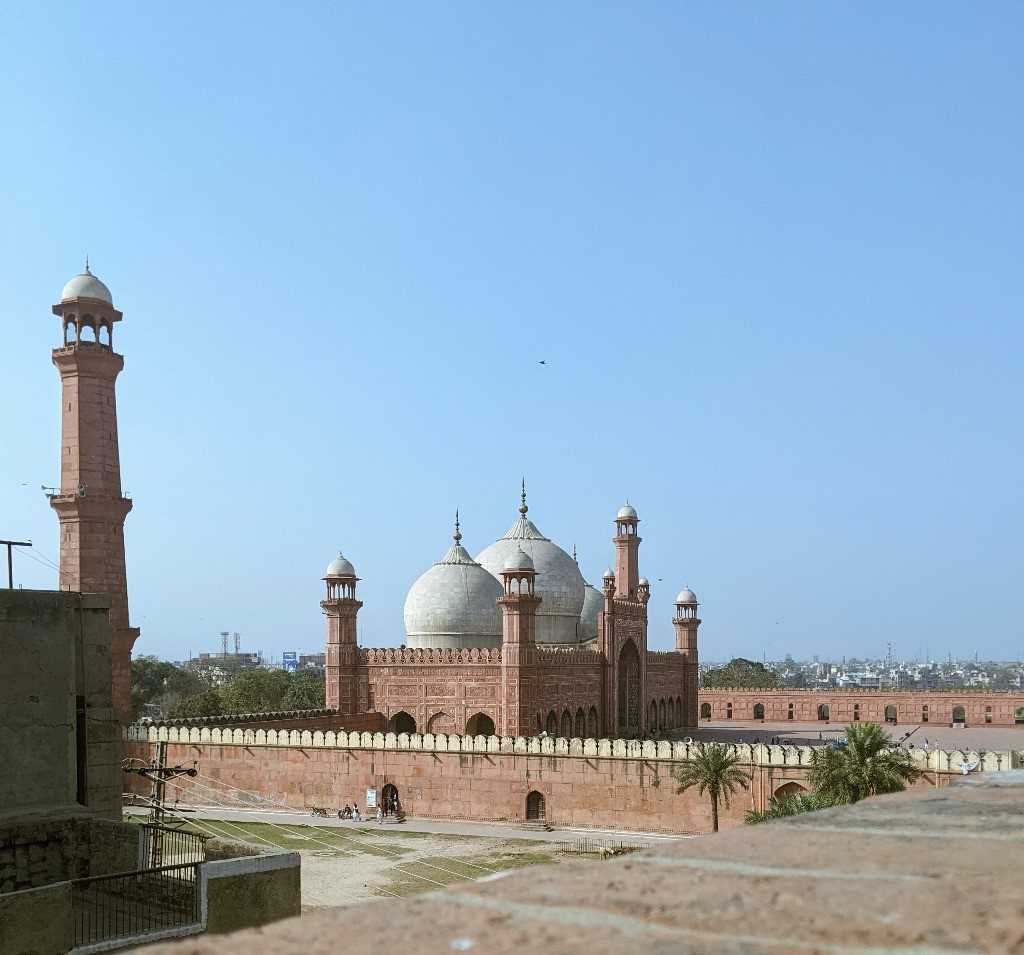
History of Badshahi Mosque:-
The Badshahi Mosque’s history is deeply intertwined with political and cultural shifts in the Indian subcontinent. Here’s a closer look at its history:
Mughal Era:
The mosque was commissioned by Emperor Aurangzeb in 1671 and completed in 1673, reflecting the Mughal Empire’s zenith. It was constructed by the Emperor’s foster brother, Muzaffar Hussein, also known as Fidai Khan Koka. Muzaffar Hussein was Lahore governor at the time. The mosque was built to commemorate Aurangzeb’s military campaigns in southern India, particularly against the Maratha Emperor Shivaji.
Sikh Rule:
In 1799, Ranjit Singh’s Sikh army took control of Lahore. The mosque’s courtyard was used as a stable for his army horses. Its hujras (small study rooms) were served as quarters for soldiers and storage for military stores. This period marked a decline in the mosque’s condition, as it was not used for worship.
British Rule:
When the British Empire took control of Lahore in 1846, the mosque continued to be used for military purposes. It served as a garrison until 1852, further contributing to its decline.
Restoration:
After Pakistan’s creation in 1947, the mosque was returned to its original purpose as a place of worship. The Badshahi Mosque Authority was established to oversee its restoration. Extensive repairs have been made to restore the mosque to its former glory.
Modern Day:
Today, the Badshahi Mosque is not only a place for prayer but also a major tourist attraction, representing Pakistan’s cultural and historical heritage. It has been restored almost to its original 17th-century condition, with continuous repairs and preservation efforts to maintain its status as a symbol of the Mughal architectural legacy.
How to Get there:-
There are two ways to get to the Badshahi Mosque from the Lahore Airport (LHE):
By taxi, you can get to Badshahi Mosque from Lahore Airport in 30 minutes. The distance is 28.2 km. The fare should be between PKR 500 and PKR 700, depending on the taxi company you choose.
There is also the option of taking the Lahore Metro Bus to Badshahi Mosque. It will take the same amount of time (30 minutes) and cover the same distance (28.2 km). The fare will be much cheaper, only PKR 40.
Best Time to Visit:-
From October through March is the best time to visit the Badshahi Mosque, as the weather is pleasant.
To avoid the heat and see the mosque in the soft light of sunrise or sunset, it is best to visit early in the morning or late in the afternoon. Visits in the morning also offer a chance to experience the peaceful atmosphere during the Fajr prayer. A beautiful sunset can also be seen in the evening, as the temperature cools down and the atmosphere is peaceful.
11 Interesting Facts About Badshahi Mosque:-
Red Sandstone Glory:
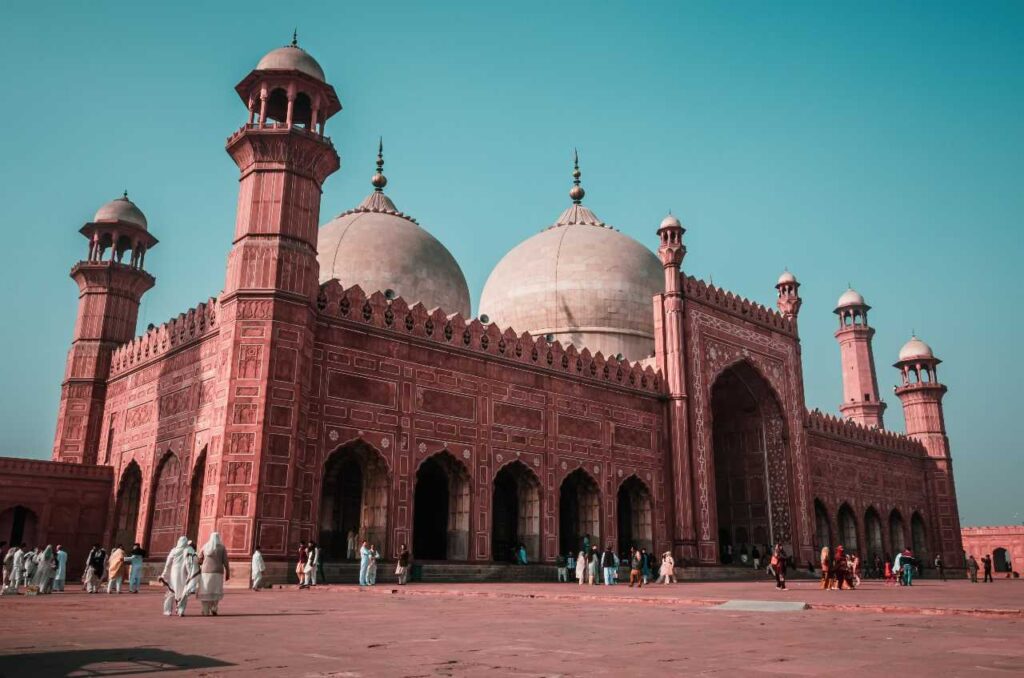
As an example of Mughal architecture, the Badshahi Mosque uses red sandstone in its construction. Due to its durability and ease of carving into delicate patterns, red sandstone was selected for the construction of the mosque, which gives it a regal and majestic appearance, fitting for its name, which translates to ‘Imperial Mosque’.
Red sandstone used in the Badshahi Mosque reflects the power and wealth of the Mughal Empire during its construction. It remains a symbol of Lahore’s rich cultural heritage.
Four Grand Gates:
The Badshahi Mosque features four grand gates, each meticulously crafted to complement the mosque’s majestic architecture. Each gate is a work of art in itself, boasting its own features and a rich history.
Gate#1 (Gate of Glory):
Standing tall at 60 feet high and 47 feet wide, the Gate of Glory lives up to its name. Built with red sandstone and adorned with intricate white marble inlay work, it features Quran verses and floral patterns. This gate was reserved for royalty and dignitaries, leading directly to the royal enclosure within the mosque.
Gate#2 (Gate of Response):
Facing the crowded bazaars of Lahore, the Gate of Response stands 53 feet high and 47 feet wide. It serves as the entry point for the general public, welcoming worshippers with open arms. The gate is adorned with elegant calligraphy and geometric patterns, showcasing Mughal artisans’ mastery.
Gate #3 (Gate of Peace):
The Gate of Peace faces the peaceful Hazuri Bagh gardens and exudes tranquility. Similar in size to Gate #2, it features intricate floral and vine carvings, adding harmony to the surrounding greenery. Scholars and religious leaders often used this gate.
Gate #4 (Gate of Felicity):
Its height and width are 53 feet, and it serves as the entrance to the majestic Lahore Fort. Mughal emperors used it to connect the mosque to their seat of power. Light and air flow through the gate, creating an atmosphere of openness and welcome due to the intricate jali work.
Dominating Domes:
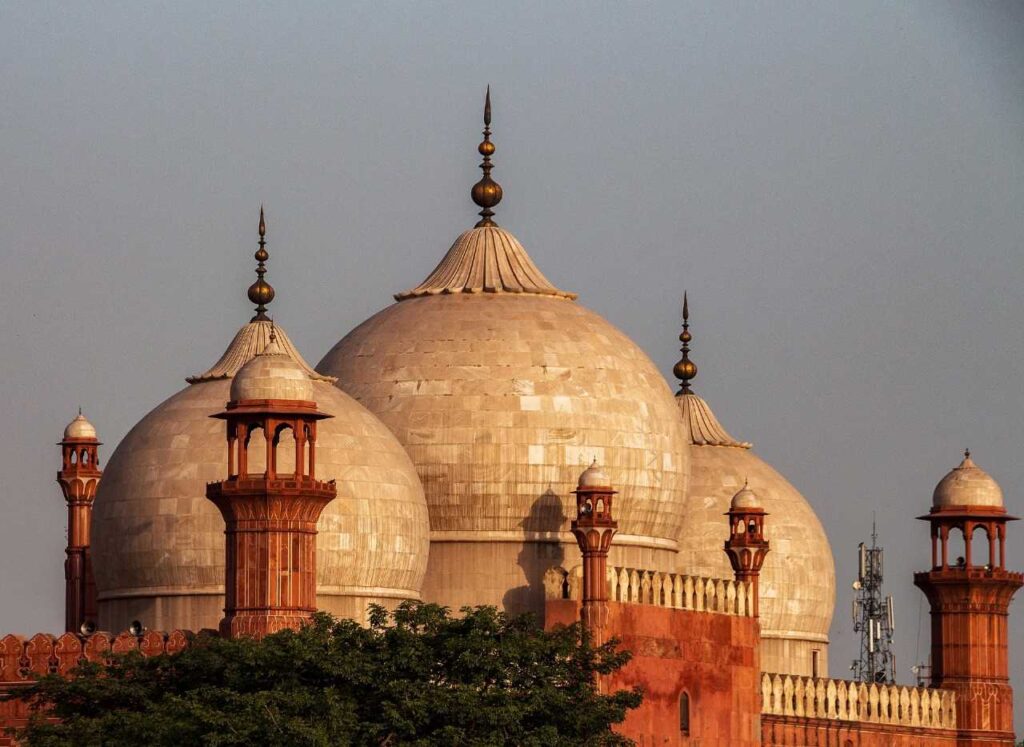
The Badshahi Mosque is crowned by three magnificent white marble domes, the central one slightly larger than the two flanking it. The largest dome spans a diameter of 54 meters and reaches 58 meters into the sky. The domes are double-layered, a typical feature of Mughal architecture, which enhances the exterior aesthetic but also regulates the interior temperature.
But the beauty of these domes extends beyond their size and aesthetics. They serve a crucial purpose in mosque acoustics. The curved surfaces reflect and amplify sound, ensuring that even the faintest whisper reaches every corner of the vast prayer hall. This incredible feat of design allowed the imam’s voice to carry across the entire audience, promoting unity and connection among worshippers.
Whispering Gallery:
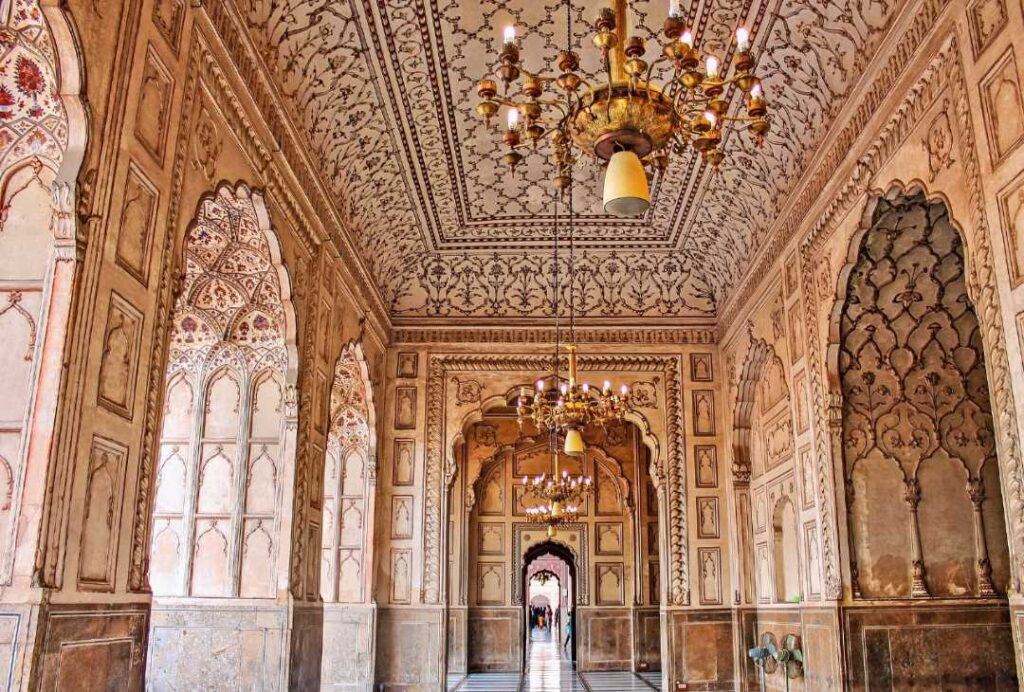
The Whispering Gallery of the Badshahi Mosque is a marvel of audio engineering. Located on the upper level of the mosque, the gallery runs around the base of three domes. It is designed so that a person whispering at one end can be clearly heard at the other, despite the distance. This architectural wonder is not only a testament to Mughal engineering style but also adds mystery to the mosque’s already rich history.
The gallery’s design utilizes the curvature of the dome and the rough surfaces of the walls to carry sound waves efficiently across the space. Visitors often experience this acoustic phenomenon, leaving them in awe of the ingenuity of the architects and builders of the time. The Whispering Gallery served a practical purpose, allowing communication in a time before modern amplification. However, it also enhanced the spiritual experience, as the soft prayers could be heard throughout the sacred space.
The Minarets:
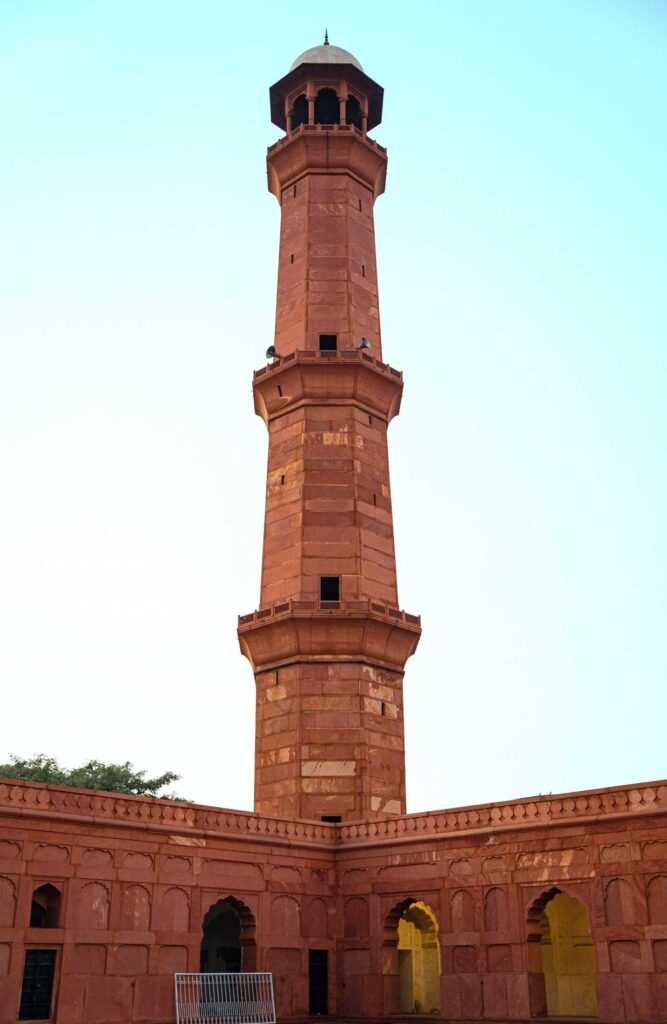
Each of the four towering minarets stands like a defiant sentinel at each corner of the Badshahi Masjid Lahore. They symbolize faith, power, and a legacy of the Mughal Empire.
These minarets are crafted from red sandstone and are a wonder of Mughal engineering. The octagonal bases of these buildings taper gracefully, with intricate marble inlay bands. The minarets are adorned with exquisitely carved balconies, each supported by ornate brackets, which serve as muezzin’s calls from their balconies, accessible via winding staircases inside the towers. However, the minarets served more than just religious purposes. During times of conflict, they served as watchtowers, offering an overview of the city.
Each step of the narrow stairs within the minarets offers breathtaking views of the city. At night, the illuminated minarets of the Badshahi Masjid Lahore cast an enchanting glow over the city.
Flood-Resistant Foundation:
Badshahi Mosque is renowned not only for its architectural splendor, but also for its flood-resistant construction. The mosque was built on a raised platform that elevated it above the surrounding cityscape and protected it from flooding.
As a result of kiln-fired bricks and lime mortar, this platform rises 10 feet above the surrounding ground. It is essentially an artificial hill that forms the foundation for the mosque. It not only elevates it above potential floodwaters, but also provides a stable base for its heavy load.
Below the platform is a labyrinthine network of interconnected chambers and drains. These channels, lined with water-resistant bricks, work like arteries to divert floodwaters away from the mosque. Due to this foresight, the Badshahi Mosque has survived as one of the most impressive and well-preserved examples of Mughal architecture on the Indian subcontinent.
Hidden Chambers:
As well as its visible structures, the Badshahi Mosque also contains several hidden chambers, whose true purpose remains a mystery.
In one conspiracy chamber is a deep well that has inky depths that are hidden from sight. Legend has it that the well was used to dispose of royal secrets, as well as the bodies of disgraced officials. Its presence adds an undeniable strangeness to the atmosphere, regardless of whether it is true or not.
As part of the mosque’s cooling system during Lahore’s unbearably hot summers, a network of ventilation shafts are located in another chamber. These shafts also serve as escape routes, allowing for discreet entry and exit. It was rumored that the mosque contained hidden treasures and secret passageways.
The Well of Mercy:
The Well of Mercy within the Badshahi Mosque is a significant spiritual feature, though it is not as commonly highlighted as the mosque’s architectural elements. The well is believed to be a source of blessing and is often visited by worshippers who seek its holy water, which is thought to have healing properties. Legends have been told about the Well of Mercy. Some say it was blessed by Sufi saints, granting wishes and curing ailments. Others whisper of its connection to a network of underground tunnels, leading to secret chambers and forgotten treasures. But beyond the tales and folklore, the well is a symbol of compassion and charity.
A UNESCO World Heritage Site:
In 1981, UNESCO included the Badshahi Masjid Lahore on its World Heritage List because of its historical and cultural significance.
Calligraphic Masterpiece:
It is believed that Badshahi Masjid Lahore is one of the best examples of Islamic calligraphy in the country. Quranic verses decorate the walls, pillars, and even the courtyard there, with different styles created by renowned calligraphers.
The Hammam:
A hidden gem can be found next to the majestic Badshahi Mosque – the Shahi Hammam, also known as the Royal Bathhouse. Stepping into the Shahi Hammam is like stepping back in time. The air still whispers of fragrant steam and laughter echoes off ancient tiled walls. The hammam was designed for luxurious bathing. Three temperature-controlled chambers await bathers. But the Shahi Hammam wasn’t just about physical cleansing. It was a social hub, a place where people from all walks of life could come together and share stories over steaming cups of chai (tea).
Other Tourist Attractions nearby Badshahi Mosque:-
Besides Badshahi Mosque, which is one of the largest mosques in the world and a masterpiece of Mughal architecture, there are many other attractions nearby:
Lahore Fort: This UNESCO World Heritage Site showcases Lahore’s rich history and culture with palaces, gardens, and museums.
Minar-e-Pakistan: The Minar-e-Pakistan stands in Greater Iqbal Park, with a national history museum and represents the Lahore Resolution of 1940 that led to Pakistan.
Masjid Wazir Khan: In Pakistan, one of the most striking mosques is Masjid Wazir Khan, a 17th-century mosque with beautiful tile work and calligraphy.
Fort Road Food Street: You can enjoy traditional and modern cuisines along with a stunning view of the Badshahi Mosque and the Lahore Fort at night.
Hotels and Restaurants:
Badshahi Mosque is close to lots of hotels and restaurants. Here are some options:
Luxus Grand Hotel: A 5-star luxurious hotel with free WiFi, free parking, a fitness center, and a restaurant. It’s 2.1 miles from Badshahi Masjid Lahore and is rated 9.2 out of 10. The price per night is $67.
Hayyat Luxury Apartments: This 4-star apartment offers free WiFi, parking, and a garden. It is 2.9 miles from Badshahi Masjid Lahore, and it has an outstanding rating of 9.4 out of 10. The price per night is $40.
Lawrence View Hotel: This three-star hotel features free WiFi, free parking, a garden, a terrace, and a restaurant. It is located 2.9 miles from Badshahi Masjid Lahore and has an excellent rating of 9.3 out of 10. The price per night is $45.
Food Street Fort Road: There’s plenty to eat on Food Street Fort Road, and you can see the Badshahi Masjid Lahore and the Lahore Fort at night. Badshahi Mosque is 0.4 miles away, and there are lots of restaurants like Haveli Restaurant, Andaaz Restaurant, and Cuckoo’s Den. The average meal costs $10.
You can Book Hotel Online From here
Local Cuisine:-
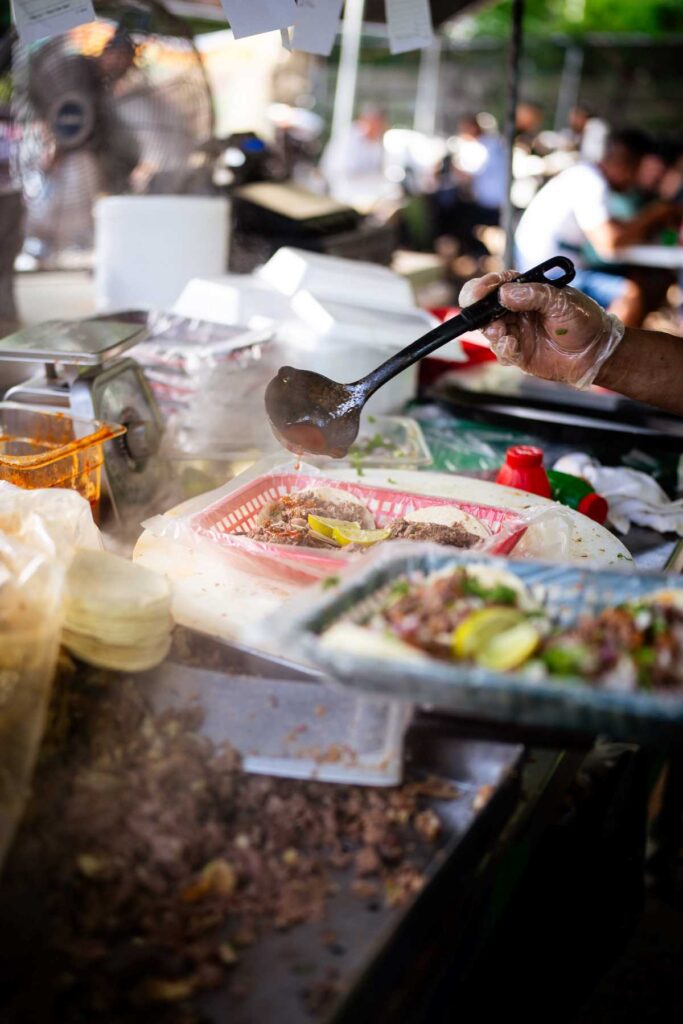
Badshahi Mosque is located in the heart of Lahore, a foodie paradise. There are many famous local cuisines near Badshahi Masjid Lahore. The most famous ones are:
Nihari: A slow-cooked stew made with beef, trotters, spices and bone marrow. It is typically served with naan or roti.
Haleem: A stew made with lentils, wheat, barley, meat, and spices. It is typically served with naan or roti.
Biryani: A dish made with rice, meat, vegetables, and spices. It is typically served with raita and a salad.
Dhaaga kabab: Minced lamb or beef marinated in spices and skewered on a thin rod. It is typically grilled or baked.
Keema Samosas: Samosas filled with minced meat and spices. They are typically deep-fried and served with chutney.
Kulfi: A traditional ice cream made with milk, sugar, and nuts. It is typically served in a cone or a cup.
Lassi: A yogurt-based drink flavored with fruits or spices. It is typically served chilled.
FAQs:-
Why Badshahi Mosque is famous?
It was the largest mosque in the world upon construction. It is the second largest mosque in Pakistan and the fifth largest mosque in the world.
Whose grave is in Badshahi Mosque?
A tomb of Muhammad Iqbal lies near the entrance of the mosque, a poet regarded in Pakistan as the founder of the Pakistan Movement, which led to the creation of Pakistan.
What is the second name of Badshahi Mosque?
The Badshahi Mosque or the ‘Emperor’s Mosque’, is a mosque in Pakistan.
What is the difference between Badshahi Masjid and Jama Masjid?
As with Jama Masjid Delhi, which was built in the 1650s by Aurangzeb’s father, Shah Jahan, this mosque also features marble domes. However, in the iwan and wider facade of Jama Masjid Delhi marble is more prominent.
Which king is buried in Lahore?
The Jahangir Tomb is a 17th-century tomb built for the Mughal Emperor Jahangir. The tomb dates from 1637, and is located in Shahdara Bagh near the city of Lahore, Pakistan, along the banks of the Ravi River.
What is the beauty of Badshahi Mosque?
This mosque is built in the Mughal architectural style, with red sandstone and marble used in construction. The mosque has four minarets, three domes, and a large courtyard. The interior is decorated with beautiful calligraphy and floral designs.
Who made Lahore Fort?
Akbar the Great held his Court in Lahore for 14 years from 1584 to 1598, and built the Lahore Fort, as well as the city walls which had 12 gates.
Which is the big Masjid in Pakistan?
The Faisal Mosque is the largest mosque in Pakistan, located in the national capital city of Islamabad. Completed in 1986, it was designed by Turkish architect Vedat Dalokay.
Why is Lahore so famous?
Lahore came to fame with Islam in South Asia and started being called the ‘Gardens of the Mughals’ or ‘City of Gardens’, after the rich heritage of the Mughal Empire.
Where is Anarkali buried?
The Tomb of Anarkali is an octagonal 16th century Mughal monument in Lahore, the capital of Punjab.
Read More
Explore a realm of fascinating travel spots and enticing locations ready to be discovered on our website. Set off on an adventure of exploration as you delve into our enlightening material, revealing the splendor of various destinations across the world.
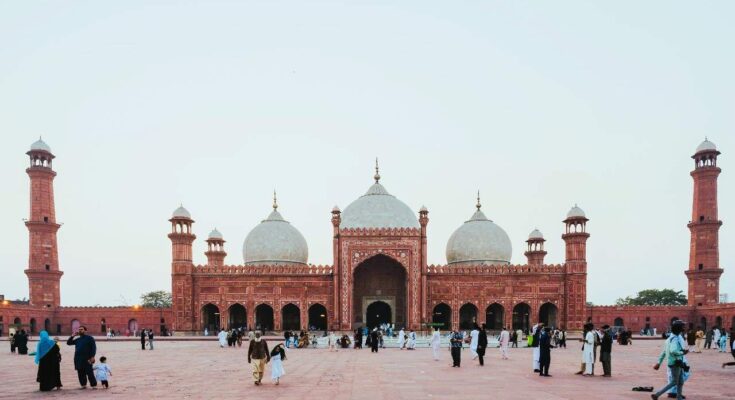

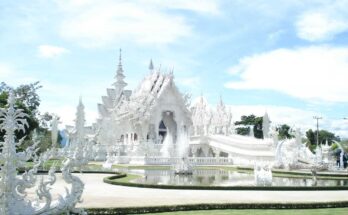
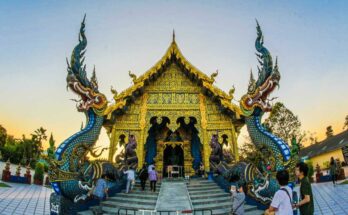
Wow, superb weblog structure! How lengthy have you ever been blogging for?
you make blogging look easy. The total look of your site is
wonderful, as smartly as the content material!
Hi would you mind letting me know which hosting company
you’re using? I’ve loaded your blog in 3 different browsers and I must say this blog
loads a lot faster then most. Can you recommend
a good hosting provider at a fair price? Thanks, I appreciate it!